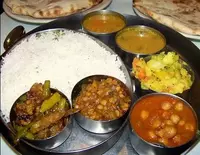The indian

Indian culinary tradition formed the basis of vegetarianism. This is explained by several reasons. First, India's climatic conditions are such that meat cannot be stored long and deteriorates quickly. Secondly, the religious regulations of Hindus do not allow them to eat beef, because the cow is a sacred animal. Muslims, of whom many live in India, do not eat pork.
These reasons collectively influenced the not relatively low popularity of meat products in the diet of Hindus. But in a huge abundance in the dishes of Indian cuisine there are vegetables. Especially strictly vegetarianism is adhered to in the south of the country. Even onions, garlic, tomatoes and beets are abandoned here. The last of these vegetables have a blood color, and therefore are not allowed to be eaten for a true vegetarian. The main products in Indian food recipes are peppers, dates, rice and lentils.
A characteristic feature of the cooking of the northern part of the country is the widespread use of wheat and ghee. Butter is considered a cleansing product, because it is made from milk of a sacred animal. In addition, the abundance of oil in the diet speaks of the wealth and well-being of the family.
Indian food recipes are striking in their diversity. Not every kitchen boasts as many flavors, flowers and flavours as are found in Indian cuisine. In many ways, this is achieved by a large number of spices that are used in the cooking process. There is evidence that the Indian hostess uses an average of about 30 different spices, which gives the dishes a special savoury taste and an incomparable aroma.
The most common in Indian food recipes are seasonings such as cumin, coriander, cinnamon, cloves, cardamom and, of course, curry - the famous Indian spice currently known around the world.
One of the most common products in India is dal, which is a cross between peas and lentils. Dal, as a rule, is combined with vegetables and forms the basis of the daily diet of very many Indians. To better imagine the significance given to Indians, we can say the following: it gave for an Indian practically the same as bread for us.
Rice, as the basis for the nutrition of Indians, is very often supplemented with various spices and sauces. The most famous Indian sauce is perhaps Massala's "massala" - a hot red sauce whose main ingredient is chilli. Another national Indian rice-based dish is "mulligatuani, " a rice soup laced with onions and plenty of garlic and pepper.
Every meal of Indians certainly ends with sweets, in the preparation and consumption of which they, no doubt, know a lot. Sweets, as a rule, are served to the table laid on leaves.
The traditional drink of Indians is, of course, tea. Indian tea is famous all over the world. In India, they prefer very hot and tightly brewed tea. Almost everywhere, tea is drunk with hot milk. Coffee is also a very common beverage in the Indian culinary tradition. It is prepared in a special way - "in Turkish, " which involves adding a few drops of pink essence to the coffee.
Indian cuisine is amazing and mysterious, as is the country itself. It is difficult for a person who is not familiar with local customs and traditions to initially accept the culinary preferences of Hindus. However, this does not detract from the merits of Indian cuisine - cuisine diverse, unique and very ancient.
 Español
Español Français
Français Português
Português Русский
Русский 简体中文
简体中文 繁體中文
繁體中文 日本語
日本語 한국어
한국어 العربية
العربية Türkçe
Türkçe Қазақ
Қазақ Deutsch
Deutsch Italiano
Italiano Українська
Українська
